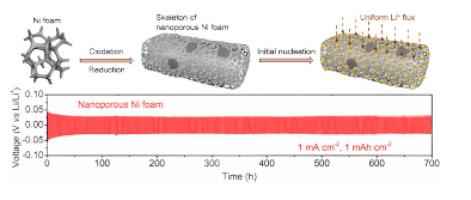Journal of Energy Chemistry ( IF 14.0 ) Pub Date : 2020-09-20 , DOI: 10.1016/j.jechem.2020.09.013 Shikun Liu , Hongming Zhang , Xiaoxu Liu , Yu Yang , Caixia Chi , Shen Wang , Junying Xue , Tingting Hao , Jiupeng Zhao , Yao Li

|
Lithium metal, as the most ideal anode material for high energy density batteries, has been researched for several decades years. However, the dendrite formation and large volume change during repetitive lithium plating/stripping lead to a serious safety issue and impede the practical application of lithium metal anode. Herein, a nanoporous Ni foam current collector with high surface area and surface flaws is constructed via a facile oxidation-reduction method. The inherent macropore structure of Ni foam can partly accommodate the volume variation during Li plating/stripping. The well-distributed nanopores on the skeleton of Ni foam can effectively reduce the local current density, regulate the uniform lithium nucleation and deposition with homogenous distribution of Li+ flux. Moreover, the surface flaws induce the formation of ring Li structures at initial nucleation/deposition processes and concave Li metal spontaneously formed based on the ring Li structures during cycling, which can direct the even Li plating/stripping. Therefore, highly stable Coulombic efficiency is achieved at 1 mA cm−2 for 200 cycles. The symmetrical cell, based on the nanoporous Ni foam current collector, presents long lifespans of 1200 and 700 h respectively at different current densities of 0.5 and 1 mA cm-2 without short circuit. In addition, the LiFePO4 full cell, with the Li metal anode based on the nanoporous Ni foam current collector, shows excellent cycling performance at 1C for 300 cycles and rate performance.
中文翻译:

构建用于稳定锂金属阳极的纳米多孔镍泡沫集电器
锂金属作为高能量密度电池最理想的阳极材料,已经研究了数十年。然而,在重复的锂镀覆/剥离过程中枝晶的形成和大的体积变化导致严重的安全问题,并且阻碍了锂金属阳极的实际应用。在此,通过简便的氧化还原法来构成表面积和表面缺陷大的纳米多孔Ni泡沫集电体。镍泡沫的固有大孔结构可以部分适应锂电镀/剥离过程中的体积变化。对Ni泡沫的骨架的良好分布的纳米孔可以有效地降低局部电流密度,调节均匀的锂成核和沉积与Li的均匀分布+通量。此外,表面缺陷在初始成核/沉积过程中诱导形成环锂结构,并且在循环过程中基于环锂结构自发形成凹入的锂金属,这可以指导均匀的锂电镀/剥离。因此,在200mA的循环中,在1mA cm -2处实现了高度稳定的库仑效率。基于纳米多孔镍泡沫集电器的对称电池在0.5和1 mA cm -2的不同电流密度下分别具有1200和700 h的长寿命,而没有短路。另外,具有基于纳米多孔镍泡沫集电器的锂金属阳极的LiFePO 4全电池在1C下300次循环中显示出优异的循环性能和倍率性能。











































 京公网安备 11010802027423号
京公网安备 11010802027423号